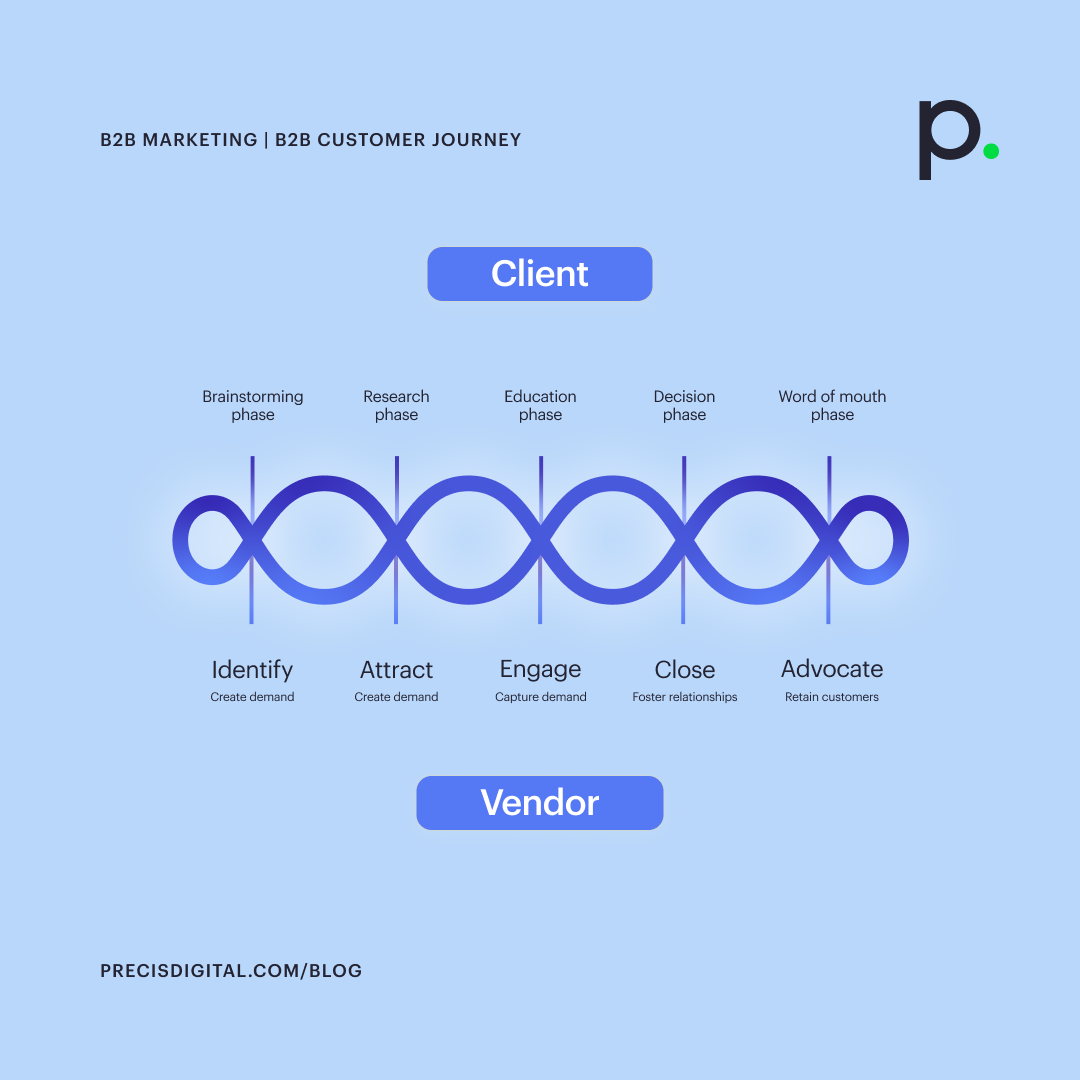A complete guide to the B2B customer journey

Daniela Nocker
Client Lead
The B2B customer journey (or B2B buying journey) is a rather complex process that typically involves many different touchpoints on the customer side. It’s important to get this process right, since businesses that understand the B2B customer journey can create a more positive customer experience, which, in turn, can lead to more sales and higher customer satisfaction. And that’s what we all want, right?
If you find yourself lost somewhere along your customer journey, we’re here to help! This blog post explores the B2B customer journey, its stages and pivotal touchpoints. As you’ll see, there are both a conventional way and a recently more prominent way to approach the B2B customer journey. We will also cover:
- The customer journey map
- Strategies to maximise customer satisfaction and loyalty
- An evaluation of a successful B2B customer journey implementation
1. What is the B2B customer journey?
The B2B (business-to-business) customer journey is the process that individuals go through when considering purchasing products or services for their business from other businesses. If you want to read about what B2B marketing is more broadly and how it works, read our complete guide to B2B marketing.
In contrast, the B2C (business-to-consumer) customer journey is the process consumers go through when considering and purchasing products or services from businesses for their private usage. While there are some similarities between the B2C and B2B customer journeys, there are also important differences to highlight:
1.1. Understanding your B2B customer journey
A clear picture of the B2B customer (or user) journey is crucial and allows businesses to:
- Improve customer experience: By understanding customers’ needs and pain points at each stage of the customer journey, businesses can create a more integrated experience for their target audience.
- Optimise marketing and sales strategies: By understanding the different channels and touchpoints potential customers use during their journey, both marketing and sales can plan and execute their strategies more effectively.
- Enhance customer satisfaction and retention: Businesses can increase customer loyalty by providing a positive customer experience throughout the journey.
1.2. The typical (and perhaps outdated?) B2B customer journey stages
The B2B customer journey includes the entire process buyers go through, from the initial awareness stage to the final purchase decision and post-purchase stage. While the specifics may vary across industries and organisations, this more traditional B2B journey (also known as a traditional funnel) generally looks as follows:
- Awareness: At this initial stage, potential B2B customers identify a need or problem and seek solutions.
- Research: During this stage, buyers look for different solutions to their challenges and rely heavily on online resources, search engines, industry publications, and peer recommendations to gather information.
- Consideration: Prospects enter this stage once they are aware of potential solutions. Here, they look at different options, compare features, and assess how well each solution aligns with their unique needs.
- Evaluation: During this stage, prospects delve deeper into the shortlisted solutions and engage with sales representatives.
- Decision: Once the evaluation is complete, buyers commit to a particular vendor and make the purchase.
- Post-decision: The (now) customers use the product or service and evaluate their satisfaction.
With the above stages in mind, it’s important to remember that, in most cases, the customer journey is not linear. Customers may move back and forth between different stages or be stuck in one. Touchpoints might also differ throughout the journey, and, in today’s world, a big part (up until the evaluation stage) is done by the buyers themselves, without any company interaction.
1.3. A more recent approach: Account-Based Marketing (ABM)
Many B2B professionals now consider the above model as a traditional outlook on the marketing funnel or customer journey. It began to face challenges as a decreasing proportion of overall generated leads resulted in sales, making it tough to prioritise it on a larger scale. This is where ABM (Account-Based Marketing) comes into play.
According to HubSpot, “Account-based marketing (ABM) is a strategic approach focusing on high-value accounts in a market or business. ABM strategies focus on creating personalised buying experiences for better customer acquisition, relationship-building, and business growth.”
ABM as a strategy has been in existence for many years, but when it comes to actual implementation by businesses, its adoption has been mixed, with many companies only recently beginning to realise its potential. This is partly due to advancements in technology and data analytics, which have made it easier to target and engage specific accounts with personalised content and messaging.
But back to why we speak about ABM in this context. ABM takes the traditional (lead-based) funnel and flips it. The strategy focuses on the following (account-based) funnel stages instead:
- Identify: Your available market is out there and, guess what? They are looking for your solution to their identified challenge, too.
- Expand: Same as above, but now the focus lies on specific target accounts that are trying to solve their identified problem.
- Engage: Potential customers are looking for qualitative content to learn more about specific products or services – now is your time to shine and stand out to them!
- Advocate: For a customer, it’s never the end of the road as it might be internally (sale went through, job done!) – customers still expect to be satisfied throughout all touchpoints.
As you might have noticed now, we’re also looking at a customer journey here – but one from a vendor’s perspective, based on accounts. You can read more about the importance of both vendor and client perspectives in the customer journey later in this article.
2. The B2B customer journey map
The B2B customer journey map visually represents a potential customer’s steps as they interact with a vendor. It shows the user’s thoughts, feelings, and actions at each stage of the journey and the touchpoints, channels, and interactions that occur.
2.1. What is the B2B customer journey map?
A customer journey map is a visual tool that businesses use to improve the customer experience. It helps companies visually identify the different touchpoints that potential customers have with their brand and understand their needs and expectations at each stage of the journey.
2.2. Identifying touchpoints, channels, and interactions
Touchpoints are when a customer interacts with a company. They can be online or offline, and they can include things like:
- Website visits
- Social media post views
- Content engagement (blog articles, videos, and so on)
- Reach-outs to sales or customer support
Channels are how customers interact with a company. They can include:
- Website
- Social media
- Phone
- Live chat
Interactions are the specific actions that customers take at each touchpoint. For example, a customer might visit the company’s website to browse content or call customer support to ask a question.
3. A visual overview of a customer journey map
Gartner’s B2B customer journey map highlights the idea of non-linearity and unpredictability and emphasises the “loop” that customers engage in across a typical B2B purchase. In fact, we believe you shouldn’t strive to understand how every single customer behaves across every single touchpoint and channel.
Another visual example of the customer journey map is B2B International’s overview, as it shows more details, including perceptions, risks and opportunities.
3.1. The B2B customer journey map (Precis’ version)
As you can see, there are many pretty and informative infographics showcasing customer journey map examples all over the internet. Really, a lot of them.
But most of them are either from the customer or vendor perspectives, rarely both. So we decided to make our own example – one that combines both areas and visualises their interconnectedness. We’ve intentionally adjusted the stages too, to ensure a more coherent integration.

However, it’s essential to remember the B2B customer journey is rarely a straightforward one – and expecting such simplicity would be (unfortunately for us marketers) overly optimistic. Therefore, our diagram should be viewed not as a set-in-stone blueprint, but rather as a flexible framework guiding the alignment of vendors and clients throughout the B2B customer journey. So we recommend you use this as a foundation to develop your own detailed and customised customer journey map based on your own specific needs.
⚠️ The “Advocate” stage should not be seen as the conclusion, but as a pivotal point that ideally feeds back into the “Identify” stage (through positive word of mouth), thereby creating a continuous customer journey loop. ⚠️
3.2. The Precis B2B customer journey map at work
So let’s put our diagram to work! Here’s an example of a customer journey map from a client’s point of view in a B2B scenario, based on our above graphic:
By understanding the details of a customer journey such as in the example above, companies can identify opportunities to improve the experience for their potential customers.
- For example, they might realise that their website is challenging to navigate, or that their sales response times are too long. By addressing such issues, the customer journey will become smoother and, as already highlighted above, overall customer satisfaction will increase.
4. Maximising the B2B customer journey with effective strategies
4.1. How do you create a successful customer journey?
Now that we looked at a customer journey example, let’s dive into effective strategies to create a successful customer journey. In general, the following tactics are key:
- Understand your customers’ needs, pain points, and goals. What are they looking for in a product or service like yours? What challenges are they facing? Once this is clear, you can tailor your marketing and sales efforts to meet their needs and personalise the customer experience for them.
- Offer a consistent omnichannel experience. Buyers expect to be able to interact with you through a variety of channels, including your website, social media, and email. Make sure that your experience is consistent across all channels so customers can easily pick up where they left off.
- Collect and analyse customer feedback. It’s essential for improving the customer journey, so make it easy for customers to provide feedback and use it to make improvements.
To ensure a positive B2B customer experience throughout all journey stages, you can start by implementing the following strategies per stage. If you peek at our infographic above, this would now be the vendor’s point of view:
- Identify: Establish a strong online presence and brand awareness for your business as potential customers might stay in this stage the longest, sometimes even completely unaware of their potential challenge (related to that, read more about Demand Generation).
- Attract: Provide valuable content through SEO and social media to attract potential customers to your business.
- Engage: Create compelling product pages, industry-focused case studies, and testimonials to showcase the value proposition of your company’s offering and differentiate yourself from competitors.
- Close: Now it’s time to streamline the purchasing process, ensuring it is convenient and transparent for potential customers. Provide comprehensive product information, answer queries, and address any concerns prospects might have. Demonstrating expertise, reliability, and excellent customer support can significantly influence the decision-making process.
- Advocate: The B2B customer journey does not end with the purchase. Now you should focus on nurturing relationships with customers by offering ongoing support, training, and proactive assistance. By doing so, you can foster loyalty, encourage repeat business, and generate positive referrals.
4.2. How do you evaluate the effectiveness of B2B customer journey strategies?
Measuring and optimising key metrics is essential for evaluating the effectiveness of B2B customer journey strategies. By tracking the right metrics, companies can identify areas where they excel and others where they need to improve.
Overall, we shouldn’t measure towards leads but look at the bigger picture instead: sales pipeline and company revenue. However, when talking about the customer journey, which heavily involves a company’s website, content and so on, we suggest tracking and evaluating these key metrics:
- Website traffic: The number of visitors coming to your website
- Conversion rate: The percentage of visitors who take a desired action, such as signing up for a newsletter or contacting sales
- Lead quality: The likelihood of a lead converting into a customer
Additional (and more sales related) metrics to measure can be:
- Sales cycle length
- Win rate
- Customer lifetime value (CLV)
Once you have collected data on the above metrics, you can use it to optimise your customer journey strategies. For example, if your website traffic is high but your conversion rate is low, you may need to improve your landing pages or calls to action.
Also, it is important to note that customer journey optimisation is an ongoing process. As your business grows and changes, your customer journey will change, too. Therefore it’s important to continuously monitor your key metrics and adjust your customer journey strategies accordingly. And that’s done in teamwork – Marketing, Sales and Customer Success all together.
Conclusion
In summary, understanding and optimising the B2B customer journey is essential for enhancing the customer experience and driving sales and satisfaction. This journey is multifaceted, encompassing stages from awareness to post-purchase, often not following a linear path.
The B2B customer journey map visually illustrates these stages and interactions, providing insights for improvement. Effective strategies involve understanding customer needs, ensuring a consistent omnichannel experience, and collecting and analysing feedback.
Measuring key metrics like website traffic, conversion rate, and lead quality helps evaluate strategy effectiveness, enabling ongoing optimisation. In today’s competitive B2B world, understanding the customer journey is crucial for building lasting customer relationships and achieving long-term success.
Psst! We’ve even held a few B2B events, too.


